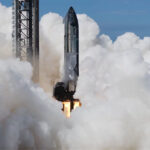The US Federal Aviation Administration (FAA) has finally granted a permit to Elon Musk’s astronautics company, SpaceX, for the highly anticipated Flight 10 Starship launch and landing test.
Starship’s Flight 10 test (IFT-10) got delayed for months because of the mishap investigations by the FAA into the previous Ship 36 explosion during ground testing.
This incident took place on Wednesday, 18th June and triggered the FAA investigation. After almost 2 months, the FAA has cleared SpaceX of any safety violations and has allowed the company to conduct the Flight 10 test.
According to SpaceX, the Flight 10 Starship launch will be attempted as soon as Sunday, 24th August at Starbase, Texas. If the first flight window is not availed due to weather or technical hurdles, the flight test might get delayed a day or two, utilizing backup windows.

Ship 36 Mishap Investigations
The FAA released the following statement on its official website as it closed the mishap investigations into Flight 10 Starship 36 explosion:
August 15, 2025
FAA Closes SpaceX Starship Flight 9 Mishap Investigation, Flight 10 Can ProceedThe FAA-required investigation of the SpaceX Starship Flight 9 mishap is closed. There are no reports of public injury or damage to public property. The FAA oversaw and accepted the findings of the SpaceX-led investigation. The final mishap report cites the probable root cause for the loss of the Starship vehicle as a failure of a fuel component. SpaceX identified corrective actions to prevent a reoccurrence of the event.
SpaceX can now proceed with Starship Flight 10 launch operations under its current license.
The FAA
In it’s Flight 10 official report, SpaceX explained the reason for the explosion of Ship 36 as:
On Wednesday, June 18 at approximately 11:00 p.m. CT, the Starship (Ship 36) preparing for the tenth flight test experienced an anomaly while on a test stand at Starbase. The vehicle was in the process of loading cryogenic propellant for a six-engine static fire when a sudden energetic event resulted in the complete loss of Starship and damage to the immediate area surrounding the stand.
As is the case before any test or launch, a safety zone was maintained around the test site and all hazards remained within the safety zone. There were no reported injuries or safety violations.
The most probable root cause was identified as undetectable or under screened damage to a composite overwrapped pressure vessel (COPV) in Starship’s payload bay section, which failed and resulted in structural failure of the vehicle causing subsequent propellant mixing and ignition. The COPVs in the payload section store gaseous nitrogen for use in the Starship environmental control system.
Ship 37
As the previously assigned Starship prototype (Ship 36) exploded before it could be launched, SpaceX had to assign another upper stage to Flight 10. Since Ship 37 was already in its testing phase, SpaceX started preparing it for the Flight 10 launch.
SpaceX has already conducted a single-engine static fire test of Starship 37 on 31st July and a six-engine static fire test on 1st August. On 13th August, SpaceX once again performed a spin prime test on Ship 37.
According to SpaceX, it has made necessary design and engineering changes and improvements in Ship 37 to mitigate the Ship 36 flaw that resulted in an explosion. SpaceX wrote in its report:
To address the issue, COPVs on upcoming flights will operate at a reduced pressure with additional inspections and proof tests added prior to loading reactive propellants onto a vehicle. SpaceX has also updated its COPV acceptance criteria and developed a new non-destructive evaluation method to detect internal COPV damage. New external covers are also being added to COPVs during their integration, adding an additional layer of protection and visual indication of potential damage.
Every lesson learned, through both flight and ground testing, continues to feed directly into designs for the next generation of Starship and Super Heavy. Two flights remain with the current generation, each with test objectives designed to expand the envelope on vehicle capabilities as we iterate towards fully and rapidly reusable, reliable rockets.
Stay tuned for future updates on Starship and SpaceX, Follow us on:
Google News | X (Twitter) | Flipboard | WhatsApp Channel | RSS (Feedly).
Related SpaceX Starship News
- The FAA gives SpaceX green light for Starship Flight 10 launch test in August
- SpaceX reveals grid fins of the next-gen Starship Super Heavy booster
- Flight 10 Starship explodes during testing at Starbase, Texas, resulting in a launch delay (video)
- SpaceX prepares for Starship’s 10th flight, conducts a static fire test on Booster 16, Starbase updates
- Trump to cancel SpaceX contracts, Musk retracts from decommissioning the Dragon spacecraft program
- Starship Flight 9 test: SpaceX misses major objectives, launch cadence to increase, says Musk
The post The FAA gives SpaceX green light for Starship Flight 10 launch test in August appeared first on Tesla Oracle.






